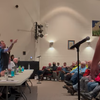Community wind in the Helderbergs It rsquo s up to the public
HILLTOWNS If a community wind project were built in the Helderbergs, it would be the first in the state. Results on a year-and-a-half study in Knox were reported, but the consultants said the next step is up to the public.
Last week, residents and officials came out to the Berne-Knox-Westerlo auditorium to hear about the groundbreaking research.
“We’re here tonight to educate you about what community wind means so you can evaluate community wind,” said Loren Pruskowski of Sustainable Energy Developments. “We’re not here to push any specific project. We’re not taking any ownership stake in the project or anything like that. We’re just here as consultants.”
The Helderberg Wind Project, a study exploring the feasibility of a community-owned wind project in the Hilltowns, was started several years ago after funds became available through the New York State Energy Research and Development Authority. Since, leaders of the project have held informational meetings and surveyed residents in the Hilltowns. They raised a 164-foot meteorological tower along Middle Road in Knox that has been taking wind measurements since October of 2006 and also conducted bird and bat studies. NYSERDA funded $119,860 of the project.
If supported by a community, three 1.5-megawatt General Electric wind turbines, estimated at $10.3 million, would be raised in the Hilltowns. The energy generated by the windmills would be sold back to the grid and offset property taxes. Assuming a 4 percent annual escalation in energy costs, Pruskowski estimated that, over 25 years, $8 million or more in revenues could be generated. The three types of wind projects, he said, differ by how electrons are used and where they are put; they may power a facility directly or be sent to distribution lines or to power transmission lines.
While other wind farms exist throughout the state, those projects are commercial, not funded by local communities.
In September of 2004, the New York State Public Service Commission adopted the Renewable Portfolio Standard, which mandates 25 percent of electricity sold in the state must come from renewable sources by 2013.
Of the nation’s 16,818 wind-power capacity, Texas leads the way with 4,356 megawatts; California is second with 2,439 megawatts, and Minnesota is third with 1,299, according to the most recent statistics from the American Wind Energy Association. As of Dec. 31, 2007, New York had 425 megawatts of installed utility-scale wind power, much of it derived from nearly 200 Danish turbines at the Maple Ridge Wind Farm on Tug Hill in Lewis County.
In 2007, the United States wind-energy industry installed 5,244 megawatts, shattering all of its previous records and expanding the nation’s total wind power generating capacity by 45 percent, according to AWEA.
Local study
Last week, the leaders of the Helderberg project Kathleen Moore of Integrated Environmental Systems, Pruskowski, and Dan Capuano of Hudson Valley Community College outlined results from their studies, discussed financing options, projected revenues, and cited world and local conditions.
Alexander “Sandy” Gordon, who represents the Helderberg Hilltowns of Berne, Knox, and Rensselaerville in the Albany County Legislature, has been a partner in the project and a proponent of alternative energies. He called wind energy “an issue of resource management.” Gordon also works for a commercial wind developer.
He said last week: “Under no circumstances am I here representing the commercial developer. This is a project that we began a couple of years ago, long before I had any association with that developer.”
Gordon sited a law in the state legislature, which would give the state siting authority over power plants and wind farms. He said, “That hasn’t been renewed…This is a home-rule state and this has a very healthy democratic process to be decided by the people in the community, if they’re for it or against it. And right now, without an Article 10 law on the books, the window is still open for local control.”
The town of Knox, which had created a windmill ordinance earlier, passed a resolution last year opposing the law.
Ownership models
Pruskowski said there are a lot of definitions of “community wind.”
“But what we mean by it is ‘local control over the development and siting of a project and local ownership of a project,’” he said, adding that a project would generate revenue from a wholesale sale of electrons.
There is an infinite amount of ways a project could be structured for a community to gain ownership, he said. There are also legal and tax issues, he said, which need to be accounted for.
Pruskowski outlined three ownership models the flip-switch model, a cooperative limited liability company, and using bonds, Clean Renewable Energy Bonds (CREBs), and tax revenue bonds.
In the flip-switch model, a large institutional tax investor partners with an LLC, which could represent the community. The LLC could also be a group of local investors, possibly a local government, although, Pruskowski said, he hasn’t yet seen it take that form. During the first 10 years, the majority 90 percent or more of the wind farm is owned by the tax investor and the majority of the revenue goes to the tax investor, who can depreciate the equipment and use the tax credits that other entities and most individuals can’t use, he said.
After 10 years, the ownership structure flips, and the majority of the wind farm is then owned by the community, Pruskowski said.
“And we would need to see a bundle energy value of $140 per megawatt in order for that project to exist,” he said.
In a cooperative LLC, a group of local residents form an LLC and pool together their money and use it as equity for down payment of a debt note.
“So that means, for a $10 million project, the local community would have to raise about $4 million in order to secure a long-term debt note,” he said.
And third, bonds are used; the owners take the output generated from the turbines as a pledge to obtain a bond.
“This is called the Helderberg Wind Project so the town of Knox has no proprietary piece of this,” said Gordon. “This is something that is information that we generated to look at the whole Hilltowns as far as a potential.”
He said of the site where the meteorological tower stands, “That’s where the actual data was generated” and has “the greatest accuracy at this point.”
“If there was another spot locally that wanted to move forward on this another town or some other configuration then correlating that data with another met tower would be a much more streamlined process,” Gordon said.
When a resident asked what happens next, Pruskowski said a development entity, which is different than the owner of the property and would represent the community, would need to be formed to keep the project moving forward. It takes about three years of data for a financier to support a project, he said.
Education
Dan Capuano, who teaches at Hudson Valley Community College, said, “Education was a really important factor in this.”
The first meeting, he said, was held in February of 2004 at the Knox Reformed Church. The group also took a field trip to a wind farm in Fenner (Madison County).
At the beginning, surveys were sent home with students at BKW and placed in local post offices and businesses. Capuano said 87 percent of those who responded to the survey wanted to see an increase in wind power.
Moore said nine sites were identified for a community wind project. Criteria for selection were based on the willingness of a landowner to host a meteorological tower, the willingness of a town to host a met tower and the turbines, and the willingness of landowners to host the turbines. The site that was chosen belongs to Amy and Russell Pokorny, who host meetings at their Octagon Barn. Moore said it was “the most accepted” but not the windiest of the nine sites. The Pokornys use both solar and wind energy to power their home.
Throughout, students helped in the project and teams were taught how to operate equipment and recorded the heights of migrating birds. Moore said the studies showed that, when it is dark, the majority of birds fly above 140 meters; 44 species of birds were identified over the course of a year, and, over a year and a half, the only species of special concern identified was a Northern Harrier. Moore said birds are killed more often by cats and by colliding with cars than by windmills. She also encouraged those in the audience to visit a wind farm to hear a windmill. She called noise “a subjective thing.”
“We only saw one bat,” she said. Daniel Driscoll, a longtime member of Knox’s planning board, said the meteorological tower is near at least four caves that he knows about.
Driscoll, who worked for the state’s Department of Environmental Conservation and the state’s Public Service Commission as a noise-control engineer before retiring, was concerned about noise that would be generated from the turbines.
Gordon said a State Environmental Quality Review Act form would be required and that Driscoll’s concerns are “very specifically addressed topics” within the process.
Questions
A number of local residents and officials asked questions, including whether a small wind farm would affect their electrical bill and whether information from the study is available to the public. Those in the audience also asked whether the school would be involved in the project, who would own the windmills, and who would insure them and protect against loss or damage.
Pruskowski said the data for the first year of the project, which was funded by NYSERDA, is available through the Freedom Of Information Law process, whereby anyone can access government records. But, he said, the group was presenting the information at the meeting. Pruskowski said energy bills would probably not be affected.
Pruskowski said the windmills could be owned by a group of local investors that form an LLC, or “the people in this room.” A school or a governing body could obtain a CREB, he said.
The next informational meeting is scheduled for July 13 at 7 p.m. at the Octagon Barn on Middle Road in Knox.


